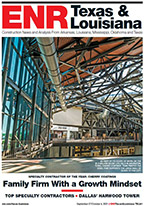Even so, in this challenging market many general contractors try to spread the work to multiple specialty contractors. Zilbermann says that still offers opportunities for the firm to provide at least one of the trades.
Design Strengths
Most company projects are design-build or design-assist. HDR, engineer of record at the Parkland project, established the criteria for the mechanical systems and empowered the contractor to take it from there, something Zilbermann views as a trend to prevent duplication of efforts. Brandt designed the system using BIM.
“Brandt helped us come up with an efficient design and a price that was within the owner's cost target for a 2-million-sq-ft hospital,” says Walt Massey, project executive on Parkland for BARA, the joint venture team of Balfour Beatty Construction, Austin Commercial, H.J. Russell and Azteca Enterprises that is the construction manager. He also is president of Balfour Beatty's national health-care group and consultancy.
The team is prefabricating the overhead mechanical and electrical, which will be installed in a rack system above the hospital corridors. The 20-ft sections are fabricated off site in a facility managed by Brandt.
High-Tech Approach
Brandt has stayed on the forefront of new technological advances. These include the use of BIM for drawings, estimating, purchasing materials and fabricating; a new business management system to manage large projects; and a work-order system for the fabrication shops that integrates with the accounting system for seamless work flows. Zilbermann says the firm's technological strength is a market differentiator. “Our strategy moving forward is continuing to use the technology available today to drive our costs down, to be more efficient and to make this a great place for smart, creative people to work,” Moore adds.
The company builds nearly every project virtually before going into the field. Brandt employs about 50 people in its BIM department. Most BIM coordinators are former field staff. “It gives them a new career path, working inside,” Zilbermann says. “And we found it easier to teach someone who knows the trade to use the BIM tool, rather than the other way around.” Brandt opened a 108,000-sq-ft, LEED-Gold certified fabrication facility in 2009 in Dallas, where it produces pipe, plumbing, sheet metal and other materials needed on jobs. Three overhead cranes handle the heavy piping.
Moving Forward
Brandt operates offices in Dallas, Fort Worth, San Antonio, Waco and Austin, but last year it has worked on projects in New Mexico and Oklahoma. “One reason for investing in fabrication and BIM is to enable us to travel more effectively,” Zilbermann says. “We can create the model, fabricate in our shops and have less field labor. With lower risk, we can travel.”









